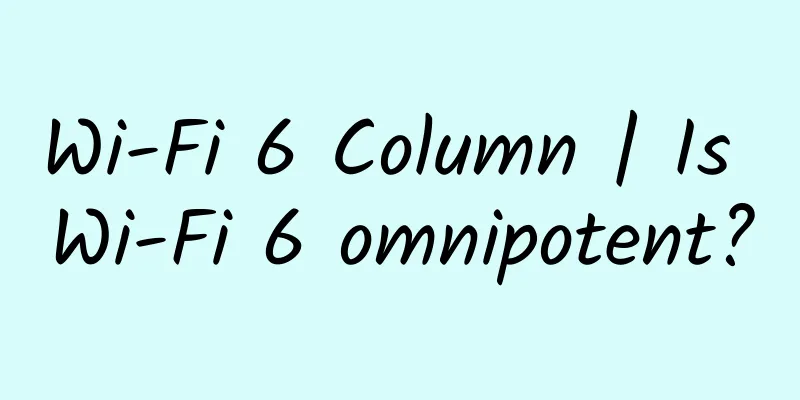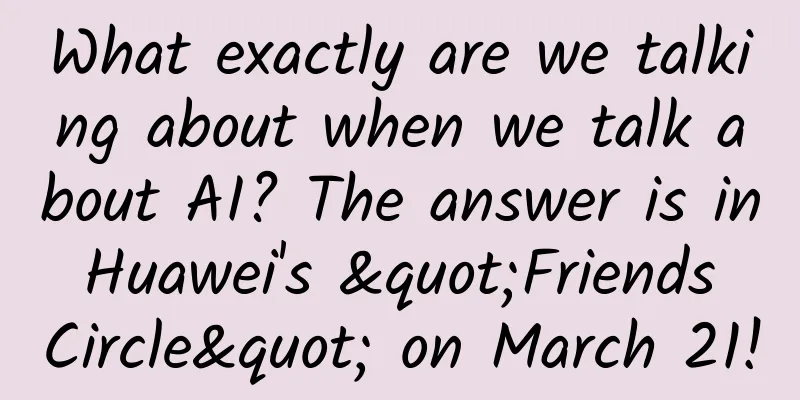Wi-Fi 6 Column | Is Wi-Fi 6 omnipotent?

|
Wireless networks have been around for a long time. What are your experiences with wireless networks? It can be said that before the birth of scenario-based wireless, the wireless network experience was substandard. At that time, you just installed APs and went around the world, and the network was interconnected. With scenario-based wireless, different wireless APs can be developed according to different application scenarios in different industries. At this time, the network experience can reach 60 points. However, scenario-based wireless is far from enough, because wireless operation and maintenance is too complicated. Later, Ruijie proposed that "network optimization does not require 'people'" and launched WIS wireless intelligent service to automate and unmanned complex wireless network operation and maintenance, and improve the wireless experience to 85 points. So if you want to achieve a wireless experience of 100 points, what should you do? ▲ Trend of Wi-Fi experience score changes Problems left over from the Wi-Fi 5 era ▲ Wi-Fi experience issues in different scenarios Question 1: From Wi-Fi 1 to Wi-Fi 5, it has been said that the wireless rate is increasing and the maximum throughput of a single user is increasing. However, users do not feel much improvement in the actual use experience, especially in offices. Why is this? Question 2: This situation is more common in student dormitories. We are in the same room and everyone pays the same amount of money, so why is my internet connection worse than others? Question 3: This feeling may be familiar to everyone. The wireless signal is clearly full, why can't I always connect, or even if I connect, why is it still difficult to use? Question 4: There are many IoT applications in factory workshops, such as AGVs and asset positioning. The frequency band of IoT overlaps with Wi-Fi, so you can only choose one, either IoT or Wi-Fi. Is it possible to have both? Question 5: In a library or waiting room, the wireless experience is fine when there are few people, but it becomes unavailable when there are many people. What’s going on? Solution to Problem 1: Wi-Fi 6 makes the network stronger To explain it in a metaphor, a car is like a message, and a lane is like a channel. Lane 1 in the left figure is normally used for message transmission in Wi-Fi 5. When lane 1 in the left figure encounters interference within the system, such as interference between APs, Wi-Fi 5 technology will arrange the interference source together with the messages being transmitted and continue to transmit them in sequence. It can be clearly seen from the figure that the transportation efficiency of this lane will definitely decrease. If the first lane in the left figure encounters a non-Wi-Fi interference source, such as interference from a microwave oven, Wi-Fi 5 technology may switch the original message to another lane for transmission. This will be more costly, which means serious packet loss. Therefore, when traditional Wi-Fi 5 encounters interference, it either sacrifices time or switches channels, and the end result is a decline in user experience. How does Wi-Fi 6 do it? As shown in the figure on the right, Wi-Fi 6 will manage lanes in a more refined manner. When encountering an interference source, Wi-Fi 6 can provide an exclusive lane for the interference source, so that normal packets and interference packets can run in the same channel at the same time. Wi-Fi 6 implements scheduling from time domain to frequency domain, making full use of spectrum resources, making the network more robust and providing a better user experience. Solution to Problem 2: Wi-Fi 6 makes the network more balanced As shown in the figure above, we regard a truck as a long message, such as a video, and a motorcycle as a short message, such as a WeChat or text message. It can be clearly seen that on this road, trucks occupy most of the resources, which explains why my network is worse than others when everyone pays the same price. Because the business of large messages accounts for a high proportion, the experience of small messages is very poor because small messages cannot grab resources. Similarly, Wi-Fi 6 will make lanes more refined. For small packets, Wi-Fi 6 can divide lanes more finely, allowing more packets to run in the lane at the same time; for large packets, Wi-Fi 6 can make lanes relatively wider. Therefore, Wi-Fi 6 uses intelligent application recognition to adapt reasonable RFID units to different packets, that is, reasonable road width and lane width. Wi-Fi 6 provides a fairer and more balanced network, so that everyone who pays the same price can get the same quality network experience. Solution to Problem 3: Wi-Fi 6 makes the network more real Why can't I connect when the signal is clearly detected and full? See the picture above. This can be understood as interference or a weak signal state. We regard this motorcycle as a weak terminal. When encountering a rough road like the one in front, the motorcycle cannot pass through and cannot even connect. How does Wi-Fi 6 do this? It still divides the lanes. As you can see from the picture above, the rocks on the road do not damage the entire road surface, and even if the road is rough, a truck can still drive through it. So Wi-Fi 6 allows motorcycles to drive on flat roads and trucks to drive on rough roads, that is, intelligently divide the upper and lower spectrums, so that Wi-Fi can be used as soon as it is visible. Then the network will be healthier and stronger, and ultimately bring a real experience. Solution to Problem 4: Wi-Fi 6 makes the network more harmonious When building Wi-Fi, users often wonder if they can build Wi-Fi and IoT together for future applications. But in fact, Bluetooth, Zigbee, etc. are almost in the same frequency band as Wi-Fi's 2.4G. Similarly, if the two are to be used at the same time, there will inevitably be certain sacrifices. Either the time slice is sacrificed, resulting in a 50% drop in the performance of the entire network; or Wi-Fi is directed to the 5G channel, resulting in the unusability of 2.4G. How to implement Wi-Fi 6? We still need to manage the roads in a refined manner, let Wi-Fi and IoT go their own ways, and divide the spectrum resources so that Wi-Fi and IoT can have both. Question 5: Wi-Fi 6 makes the entire network more efficient The four problems mentioned above have certain limitations. They may be confined to a relatively small network, which may have only one AP. In fact, Wi-Fi 6 has made many optimizations not only to a single AP, but also to the entire network. For example, when many people are meeting in a conference room, when the host is speaking, if someone speaks as loudly as the host, then the possibility of the host's voice being heard by others becomes smaller. If the people in the conference room are divided into four groups, then the host only selectively listens to the voices of the members in the group, so that everyone in the four groups can actually hear the speech of anyone in the group. Wi-Fi 6 also makes the entire network more efficient through grouping behavior.
|
<<: Ten features of IPv6 that are superior to IPv4
>>: Monaco becomes the first country to have full 5G coverage, supported by Huawei technology
Recommend
A must-have for interviews! 15 classic questions about TCP protocol!
[[410649]] Preface TCP protocol is a must-know kn...
GigsGigsCloud: $26/year KVM-1GB/15G SSD/2TB/Los Angeles Data Center
GigsGigsCloud has launched a new VPS in the Los A...
6 AI Elements You Need for a Wireless Network Strategy
Thanks to advances in artificial intelligence (AI...
The computing power network has its own calculations
In recent years, the wave of digitalization has c...
Huawei Cloud Online Education Innovation Season is launched, 365 innovation upgrade package fully empowers education upgrade in the 5G era
[51CTO.com original article] Recently, Internet e...
How to jointly build and share 5G networks?
[[379482]] This article is reprinted from the WeC...
Wi-Fi 6 is here, are you interested?
If we were to vote for the "hottest names&qu...
How can operators innovate traffic management models?
Traffic is an important carrier in the Internet+ ...
Five firewall configuration mistakes to avoid
A misconfigured firewall can be just as dangerous...
UCloud: Shanghai/Beijing cloud server annual payment starts from 62 yuan, Hong Kong/Taiwan cloud server annual payment starts from 150 yuan
The tribe once shared information about UCloud, U...
Several steps and tools for troubleshooting the network
Let me ask a question first. If one day you sudde...
Stop shouting slogans, how to implement IPv6? Operators give details
IPv6, which is "not fast enough to keep up w...
5G development is timely and network construction should be moderately advanced
At present, the overall development of 5G in the ...
Keda releases global perception trinocular camera | one device can do three things
In all kinds of safe and bright construction For ...









